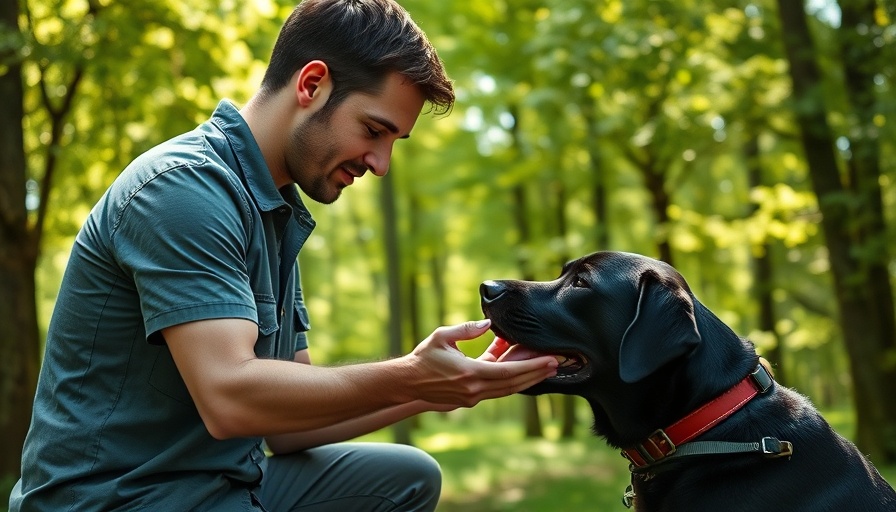
Understanding the Power of Dog Sign Language
When it comes to dog training, the unspoken bond between you and your furry friend can speak louder than words. Many dog owners overlook the potential of body language, especially hand signals, when communicating with their pets. As research has suggested, our four-legged companions not only listen to our words but are keen observers of our gestures. From sit commands to playful paw shakes, using hand signals could unlock a new level of communication and connection with your dog.
Why Dogs Prefer Hand Signals
Dogs have evolved to attentively read human body language, often relying more on gestures than verbal commands. A fascinating study published in Animal Cognition illustrates that dogs respond better to visual cues. It's a fact many trainers emphasize: consistent gestures create clarity for dogs, making them more likely to understand your intentions. This is especially useful not just for hearing dogs but also for those experiencing age-related hearing loss. Training with hand signals from an early stage can foster a lifelong understanding.
How to Get Started with Hand Signals
If you are interested in incorporating hand signals into your dog training routine, starting simple is key. Establish motions for basic commands; the typical “sit” can be signaled by raising a closed fist above the dog's head or holding your hand out with your fingers pointing up. Similarly, “down” can be signaled by moving your hand down towards the ground. No special vocabulary is necessary—your choice of gestures should feel natural and comfortable to you.
The Benefits of Using Sign Language in Training
Using sign language in dog training offers numerous benefits beyond just effective communication. It enhances your dog's focus and attentiveness, fosters more engagement during training sessions, and strengthens your bond through consistent interaction. The emotional connection deepens as your dog begins to recognize non-verbal cues; this unspoken dialogue creates a profound trust between you two. Additionally, employing hand signals can help mitigate frustration during training, as both you and your dog can communicate more effectively without the barriers of sound.
Parallel Examples of Successful Training Techniques
Many dog trainers have reported stunning successes when integrating hand gestures into their training routines. For example, a local trainer, Kathy Callahan, has noted how rescue dogs, who often have a tumultuous past, respond remarkably well to visual cues. This is particularly evident in dogs with special needs, such as those that are deaf or hard of hearing. They thrive on the clear communication provided by sign language training.
Future Trends in Dog Training
As we progress towards a more humane approach to dog training, the reliance on gentle guidance and understanding our pets' psychology is at the forefront. The trend is shifting increasingly toward leveraging body language rightly, as training that uses fewer verbal commands tends to align with the canine way of communication. Expect to see more dog training classes incorporating sign language as an alternative or complement to traditional verbal cues.
Common Misconceptions About Dog Training
There’s a common misconception that dogs only understand verbal commands. Many believe that for a command to stick, it has to be spoken out loud. In reality, dogs are perfectly capable of understanding visual cues. While verbal commands are certainly valuable, they can sometimes overwhelm a dog, especially when multiple cues are given at once. Utilizing a balanced approach of both hand signals and verbal commands will likely yield the best results.
Practical Training Tips You Can Implement Today
Starting today, there are several effective strategies to implement hand signals into your dog training routine:
- Be Consistent: Use the same signal for the same command every time. Consistency breeds understanding.
- Reward Good Behavior: Pair hand signals with treats to reinforce the behavior.
- Practice in Various Environments: Introduce hand signals in different settings to generalize the commands.
- Gradual Addition of Verbal Cues: Once your dog responds to gestures, gradually add verbal commands.
- Engage with Enthusiasm: Your energy and positivity will translate to your dog and encourage their participation.
Building a Lasting Communication with Your Pet
As you embark on this journey of learning hand signals with your furry companion, remember that the goal is a better understanding rather than merely obedience. Training through signs not only empowers your pet but also strengthens the bond you share. Both your communication and your dog's learning experience will become more pleasurable and efficient when movement speaks volumes.
If you're eager to embrace the art of dog sign language in your training regimen, now is the perfect time to integrate these techniques into your daily routines. By fostering a learning environment that emphasizes non-verbal communication, you're ensuring that you'll not only train effectively but also build an enriching relationship with your dog.
Take action today—try introducing just one new hand signal command during your next training session and witness the magic unfold. Your dog is ready to learn, so why wait?
 Add Row
Add Row  Add
Add 




Write A Comment